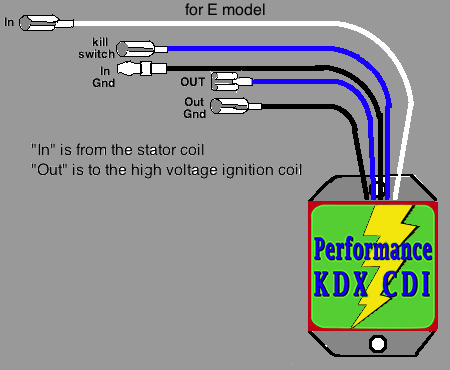|
INSTALLING THE KDX PERFORMANCE CDI CONNECTION: The Performance CDI has five wires, all with the same length as the original CDI. You can connect each wire after disconnecting each wire of the original CDI.  If there is any doubt as to which wire is which then you can use an ohm-meter to measure resistance. The wires from the ignition coil should read almost zero ohms. The wires from the stator coil should read close to 380 ohms. With the meters black probe on chassis ground and the red probe on the kill switch wire it should read infinite resistance until you press the kill button at which time it should read zero ohms. Questions & Answers Does it come waterproof? There is sealant where the wires come out of the box and you will need to put sealant on the box lid to seal it once you decide on which switch setting is the best for you. You can use silicone sealant on the lid because it is easy to break later on if you want to open the lid again to change the switch setting. Ideally the exposed switches should also be covered with silicone sealant which you can do after you have settled on the best switch settings. You can put a small amount of toilet tissue on top of the switches before sealing them so that their levers will still be free to move in the future if you want to reposition them after removing the new layer of sealant you put over them. Why aren't the switches sticking out of the box so they can be manipulated without removing the lid? Because switches aren't waterproof. They need to be inside the box and isolated from any water splashing up onto the CDI. Water entering into the switch will corrode the metal switch contacts and create electrical resistance there. It's best to start out by centering your stator coil plate if you have the needed tool to remove the magneto. Moving the stator plate clockwise causes more timing curve advance and moving it counter-clockwise causes more timing curve retard. Even better is to use a timing light to set the plate for 19 degrees BTDC ignition timing at 6000 RPM with the stock CDI. Then install the Performance CDI and go riding with pen and paper and tools to remove the seat and the CDI screws. If you take off the box lid (using a small phillips screwdriver) you will see the two micro switches on the components board. The Mid Range Boost switch has 3 positions for High, medium, and low. Higher gives more timing advance which is better for woods riding and worn out engines (less than 150psi compression), and lower advance is better for racing (because of better high RPM power) and fresh top ends (new rings with no deep cylinder scratches). The combination of switch settings should be sought which gives the best mid range and top end power. Most generally the best setting is that which gives more timing advance at 3500 RPM, and less timing advance than stock on up to peak RPM (9000 RPM). But unfortunately I can't recommend the best setting if your stator plate has had its position changed from factory setting. To return it to factory setting you have to use a timing light and adjust the plate to have 19 degrees BTDC as the ignition timing at 6000 RPM. Concerning compression the 1989-1994 KDX200E manual states that 119-185 psi is the acceptable compression range and the 1995-2006 KDX200H manual states that 91-155 psi is the acceptable compression range. For the factory stator plate location I recommend these settings based on your engines compression:
Regardless of my "ideal" recommendations I recommend that you try all three "M.R. Boost" settings twice, once with H.R. Boost off and once with H.R. Boost on. Take notes on how each of the six settings feel from 4000 RPM on up. Start with the engine already fully heated up since power is lost as engine temperature rises. If in doubt then choose less advance since more advance increases engine temperature What throws things off are changes in jetting, porting, and pipe. Each of these requires different timing so it is best to test all 6 combination settings. Also it is easier to evaluate engine power on an incline although it is hard to find one that is long and maintains the same grade inclination. Click here to read more about available timing curves. |